Get Free NCERT Solutions for Class 11 Maths Chapter 16 Probability Ex 16.3 PDF in Hindi and English Medium. Probability Class 11 Maths NCERT Solutions are extremely helpful while doing your homework. Probability Ex 16.3 Class 11 Maths NCERT Solutions were prepared by Experienced LearnCBSE.online Teachers. Detailed answers of all the questions in Chapter 16 Class 11 Probability Ex 16.3 provided in NCERT Textbook.
- Probability Class 11 Ex 16.1
- Probability Class 11 Ex 16.2
- Probability Class 11 Ex 16.3
- Probability Class 11 Miscellaneous Exercise
- प्रायिकता प्रश्नावली 16.1 का हल हिंदी में
- प्रायिकता प्रश्नावली 16.2 का हल हिंदी में
- प्रायिकता प्रश्नावली 16.3 का हल हिंदी में
- प्रायिकता विविध प्रश्नावली का हल हिंदी में
Free download NCERT Solutions for Class 11 Maths Chapter 16 Probability Ex 16.3 PDF in Hindi Medium as well as in English Medium for CBSE, Uttarakhand, Bihar, MP Board, Gujarat Board, BIE, Intermediate and UP Board students, who are using NCERT Books based on updated CBSE Syllabus for the session 2019-20.
NCERT Solutions for Class 11 Maths Chapter 16 Ex 16.3
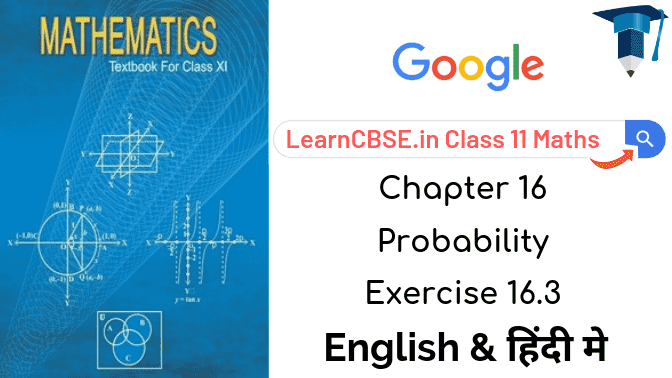
Question 1.
Which of the following cannot be valid assignment of probabilities for outcomes of sample space
S = {⍵
1
, ⍵
2
, ⍵
3
, ⍵
4
, ⍵
5
, ⍵
6
, ⍵
7
}
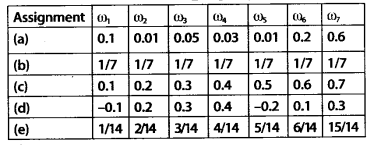
Solution:
(a) Sum of probabilities = 0.1 + 0.01 + 0.05 + 0.03 + 0.01 + 0.2 + 0.6 = 1.00
∴ Assignment of probabilities is valid.
(b) Sum of probabilities
\(=\frac { 1 }{ 7 } +\frac { 1 }{ 7 } +\frac { 1 }{ 7 } +\frac { 1 }{ 7 } +\frac { 1 }{ 7 } +\frac { 1 }{ 7 } +\frac { 1 }{ 7 } =\frac { 7 }{ 7 } =1\)
∴ Assignment of probabilities is valid.
(c) Sum of probabilities
= 0.1 + 0.2 + 0.3 + 0.4 + 0.5 + 0.6 + 0.7 = 2.8
Sum of probabilities is greater than 1.
∴ This assignment of probabilities is not valid.
(d) Probability of any event cannot be negative. Therefore, this assignment of probabilities is not valid.
(e) The last probability \(\frac { 15 }{ 14 } \) is greater than 1.
∴ This assignment of probabilities is not valid.
Question 2.
A coin is tossed twice, what is the probability that atleast one tail occurs?
Solution:
An experiment consists of tossing a coin twice.
The sample space of the given experiment is given by
S = {HH, HT, TH, TT}
Let E be the event of getting atleast one tail.
Then, E = {HT, TH, TT}
∴ \(P\left( E \right) =\frac { n\left( E \right) }{ n\left( S \right) } =\frac { 3 }{ 4 } \)
Question 3.
A die is thrown, find the probability of following events:
(i) A prime number will appear;
(ii) A number greater than or equal to 3 will appear;
(iii) A number less than or equal to one will appear;
(iv) A number more than 6 will appear;
(v) A number less than 6 will appear.
Solution:
An experiment consists of throwing a die.
∴ The sample space of the experiment is given by S = {1, 2, 3, 4, 5, 6}
(i) Let E be the event that a prime number will appear.
∴ \(P\left( E \right) =\frac { n\left( E \right) }{ n\left( S \right) } =\frac { 3 }{ 6 } =\frac { 1 }{ 2 } \)
(ii) Let F be the event that a number ≥ 3 will appear.
F ={3, 4, 5, 6}
∴ \(P\left( E \right) =\frac { n\left( F \right) }{ n\left( S \right) } =\frac { 4 }{ 6 } =\frac { 2 }{ 3 } \)
(iii) Let G be the event that a number ≤ 1 will appear.
G={l}.
∴ \(P\left( G \right) =\frac { n\left( G \right) }{ n\left( S \right) } =\frac { 1 }{ 6 } \)
(iv) Let H be the event that a number more than 6 will appear.
H = ⌽
∴ \(P\left( H \right) =\frac { n\left( H \right) }{ n\left( S \right) } =\frac { 0 }{ 6 } =0\)
(v) Let I be the event that a number less than 6 will appear.
I = (1, 2, 3, 4, 5}
∴ \(P\left( I \right) =\frac { n\left( I \right) }{ n\left( S \right) } =\frac { 5 }{ 6 } \)
Question 4.
A card is selected from a pack of 52 cards.
(a) How many points are there in the sample space?
(b) Calculate the probability that the card is an ace of spades.
(c) Calculate the probability that the card is
(i) an ace
(ii) black card.
Solution:
(a) There are 52 cards in a pack.
⇒ Number of points in the sample space S = n(S) = 52
(b) Let E be the event of drawing an ace of spades.
There is only one ace of spade n(E) = 1 and n(S) = 52
∴ \([P\left( E \right) =\frac { n\left( E \right) }{ n\left( S \right) } =\frac { 1 }{ 52 } \)
(c)
(i) Let F be the event of drawing an ace. There are 4 aces in a pack of 52 cards. n(F) = 4, n(S) = 52
∴ \(P\left( F \right) =\frac { n\left( F \right) }{ n\left( s \right) } =\frac { 4 }{ 52 } =\frac { 1 }{ 13 } \)
(ii) Let G be the event of drawing a black card. There are 26 black cards. n(G) = 26, n(S) = 52
∴ \(P\left( G \right) =\frac { n\left( G \right) }{ n\left( S \right) } =\frac { 26 }{ 52 } =\frac { 1 }{ 2 } \)
Question 5.
A fair coin with 1 marked on one face and 6 on the other and a fair die are both tossed.
Find the probability that the sum of numbers that turn up is
(i) 3
(ii) 12.
Solution:
An experiment consists of tossing a coin marked 1 and 6 on either faces and rolling a die.
∴ The sample space of the experiment is given by
S = {(1, 1), (1, 2), (1, 3), (1, 4), (1, 5), (1, 6), (6, 1), (6, 2), (6, 3), (6, 4), (6, 5), (6, 6)}
(i) Let E be the event that sum of number is 3.
E = {(1,2)} ⇒ n(E) = 1
n(S)= 12
∴ \(P\left( E \right) =\frac { n\left( E \right) }{ n\left( S \right) } =\frac { 1 }{ 12 } \)
(ii) Let F be the event that sum of number is 12.
∴ F = {(6, 6)} ⇒ n(F) = 1 and n(S) = 12
⇒ \(P\left( E \right) =\frac { n\left( F \right) }{ n\left( S \right) } =\frac { 1 }{ 12 } \)
Question 6.
There are four men and six women on the city council. If one council member is selected for a
committee at random, how likely is it that it is a woman?
Solution:
There are 6 women and 4 men.
An experiment consists of selecting a council member at random.
∴ n(S) = 10
Let E be the event that the selected council member will be a woman.
n(E) = 6
∴ \(P\left( E \right) =\frac { n\left( E \right) }{ n\left( S \right) } =\frac { 6 }{ 10 } =\frac { 3 }{ 5 } \)
Question 7.
A fair coin is tossed four times, and a person win Re. 1 for each head and lose Rs. 1.50 for each tail that turns up.
From the sample space calculate how many different amounts of money you can have after four tosses and the probability of having each of these amounts.
Solution:
An experiment consists of tossing a fair coin four times. Therefore, the sample space of the given experiment is given by S = {HHHH, HHHT, HHTH, HTHH, THHH, HHTT, HTTH, HTHT, THTH, TTHH, THHT, HTTT, THTT, TTHT, TTTH, TTTT}
∴ n(S) = 16
According to question, we have
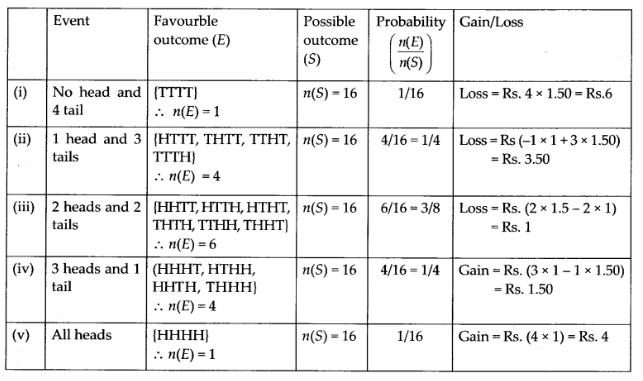
Question 8.
Three coins are tossed once.Find the probability of getting
(i) 3 heads
(ii) 2 heads
(iii) atleast 2 heads
(iv) atmost 2 heads
(v) no head
(vi) 3 tails
(vii) exactly two tails
(viii) no tail
(ix) atmost two tails
Solution:
An experiment consists of tossing 3 coins
∴ The sample space of the given experiment is given by
S = {HHH, HHT, HTH, THH, TTH, THT, HU ITT}
∴ n(S) = 8
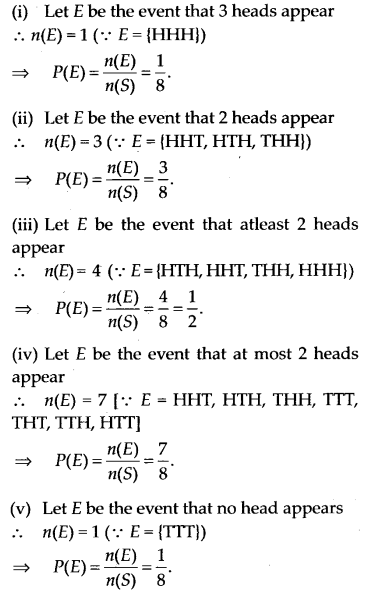
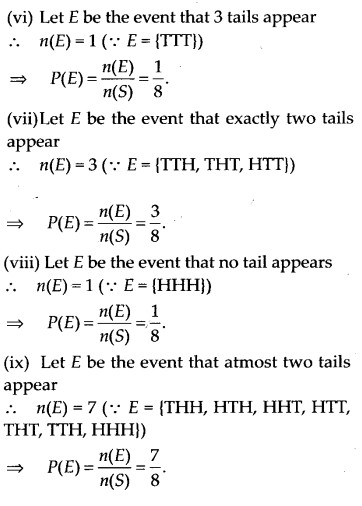
Question 9.
If \(\frac { 2 }{ 11 } \) is the probability of an event, what is the probability of the event’not A’.
Solution:
Let P(A) = \(\frac { 2 }{ 11 } \)
P(not A) = 1 – P(A) = \(1-\frac { 2 }{ 11 } =\frac { 9 }{ 11 } \).
Question 10.
A letter is chosen at random from the word ‘ASSASSINATION’. Find the probability that letter is
(i) a vowel
(ii) a consonant.
Solution:
An experiment consists of a letter chosen at random from the word ‘ASSASSINATION’ which consists 13 letters,
(6 vowels and 7 consonants).
∴ Sample points are 13.
(i) Let E be the event that chosen letter is a vowel
E = {A, A, A, I, I, O}
∴ n(E) = 6
⇒ \(P\left( E \right) =\frac { n\left( E \right) }{ n\left( S \right) } =\frac { 6 }{ 13 } \).
(ii) Let E be the event that chosen letter is a consonant
∴ F = {S, S, S, S, N, N, T}
⇒ \(P\left( F \right) =\frac { n\left( F \right) }{ n\left( S \right) } =\frac { 7 }{ 13 } \)
Question 11.
In a lottery, a person chosen six different natural numbers at random from 1 to 20, and if these six numbers match with the six numbers already fixed by the lottery committee, he wins the prize. What is the probability of winning the prize in the game? [Hint: Order of the numbers is not important]
Solution:
An experiment consists of a lottery, a person chose six different natural numbers at random from 1 to 20.
∴ Sample points
=
26
C6 = \(\frac { 20\times 19\times 18\times 17\times 16\times 15 }{ 1\times 2\times 3\times 4\times 5\times 6 } =38760\)
Let E be the event that chosen six numbers match with the six numbers already fixed by the lottery committee, i.e. Winning the prize, in the game
n(E) =
6
C
6
= 1
∴ \(P\left( E \right) =\frac { n\left( E \right) }{ n\left( S \right) } =\frac { 1 }{ 38760 } \)
Question 12.
Check whether the following probabilities P(A) and P(B) are consistently defined.
(i) P(4) = 0.5, P(B) = 0.7, P(A∩B) = 0.6
(ii) P(A) = 0.5, P(S) = 0.4, P(A ∪ B) = 0.8
Solution:
(i) P(A ∩ B) must be less than or equal to P(A) and P(B)
∴ P(A ∩ B) = 0.6 > 0.5 = P(A)
∴ P(A) and P(B) are not defined consistently.
(ii) P(A ∩ B) = P(A) + P(B) – P(A ∪ B)
= 0.5 + 0.4 – 0.8
= 0.9 – 0.8 = 01
∴ P(A ∩B) = 0.1 < 0.5 = P(A)
and P(A ∩ B) = 0.1 < 0.4 = P(B)
Thus, P(A) and P(B) are consistently defined.
Question 13.
Fill in the blanks in following table:
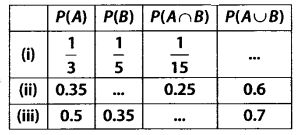
Solution:
(i) P(A ∪B) = P(A) + P(B) – P(A∩B)
\(\frac { 1 }{ 3 } +\frac { 1 }{ 5 } -\frac { 1 }{ 15 } =\frac { 5+3-1 }{ 15 } =\frac { 7 }{ 15 } \)
(ii) P(A∪B) = P(A) + P(B) – p(A ∩B)
⇒ 0.6 = 0.35 + P(B) – 0.25
∴P(B) = 0.6 – 0.35 + 0.25 = 0.5
(iii) P(A∪B) = P(A) +P(B) – P(A∩B)
⇒ 0.7 = 0.5 + 0.35 – P(A∩B)
∴P(A∩B) = 0.5 + 0.35 – 0.7 = 0.15
Question 14.
Given P(4) = \(\frac { 3 }{ 5 } \) and P(B) = \(\frac { 1 }{ 5 } \) Find P{A or B), if A and B are mutually exclusive events.
Solution:
When A and B are mutually exclusive events.
⇒ A ∩ B = ⌽
⇒ P(A ∩ B) = 0
∴ P(A∪B) = P(A) + P(B) = \(\frac { 3 }{ 5 } +\frac { 1 }{ 5 } =\frac { 4 }{ 5 } \)
Question 15.
If E and Fare events such that P(E) = \(\frac { 1 }{ 4 } \), P(F) = \(\frac { 1 }{ 2 } \) and
P(E andF) = \(\frac { 1 }{ 8 } \), find
(i) P(E or F),
(ii) P(not E and not F).
Solution:
(i) P(E or F) = P(E ∪F)
= P(E) + P(F) – P(E ∩F)
\(=\frac { 1 }{ 4 } +\frac { 1 }{ 2 } -\frac { 1 }{ 8 } =\frac { 2+4-1 }{ 8 } =\frac { 5 }{ 8 } \)
(ii) not E and not F = E’ ∩ F’ = (E ∩ F)’
(De Morgan’s Law)
∴ P(not E and not F) = P(E ∪ F)’
=1 – P(E∪F) = \(1-\frac { 5 }{ 8 } =\frac { 3 }{ 8 } \)
Question 16.
Events E and F are such that P(not E or not F) = 0.25. State whether E and F are mutually exclusive.
Solution:
not E or not F = E’ ∪ F’ = (E ∩ F)’
(De Morgan’s Law)
∴ P(not E or not F) = P(E ∩ F)’ = 1 – P (E ∩ F)
⇒ 0.25 = 1 – P(E ∩ F)
⇒ P(E ∩ F) = 1 – 0.25 = 0.75 ≠ 0
∴ Events E and F are not mutually exclusive.
Question 17.
A and B are events such that P(A) = 0.42, P(B) = 0.48 and P(A and B) = 0.16. Determine
(i) P(not A),
(ii) P(not B) and
(iii) P(A or B)
Solution:
(i) P(not A) = P(A) = 1 -P(A) = 1 -0.42 = 0.58
(ii) P(not B) = P(B’) = 1 – P(B) = 1 – 0.48 = 0.52
(iii) P(A or B) = P(A∪B)
= P(A) + P(B) – P(A ∩ B) = 0.42 + 0.48 – 0.16 = 0.74.
Question 18.
In Class XI of a school 40% of the students study Mathematics and 30% study Biology. 10% of the class study
both Mathematics and Biology. If a student is selected at random from the class, find’the probability that he will be studying Mathematics or Biology.
Solution:
Let E and F be the events that students study Mathematics and Biology respectively. Probability
that students study Mathematics i.e.,
\(P\left( E \right) =\frac { 40 }{ 100 } =0.4\)
Probability that students study Biology i.e.,
\(P\left( F \right) =\frac { 30 }{ 100 } =0.3\)
Probability that students study both Math-ematics and Biology i.e.,
\(P\left( E\cap F \right) =\frac { 10 }{ 100 } =0.1\)
We have to find the probability that a student studies Mathematics or Biology, i.e., P(E ∪ F)
Now, P(E ∪ F) = 0.4 + 0.3 – 0.1 = 0.6
Question 19.
In an entrance test that is graded on the basis of two examinations, the probability of a randomly chosen student passing the first examination is 0.8 and the probability of passing the second examination is 0.7.
The probability of passing atleast one of them is 0.95. What is the probability of passing both?
Solution:
Let E be the event that the student passes the first examination and F be the event that the student passes the second examination. Then P(E) = 0.8, P(F) = 0.7, and P(E u F) = 0.95 We know that
P(E ∪F) = P(E) + P(F) – P(E ∩ F)
⇒ 0.95 = 0.8 + 0.7 -P(E∩F)
⇒ 0.95 = 1.5 – P(E∩F)
∴ P(E∩F) = 1.5 – 0.95 = 0.55.
Question 20.
The probability that a student will pass the final examination in both English and Hindi is 0.5 and the probability of passing neither is 0.1. If the probability of passing the English examination is 0.75, what is the probability of passing the Hindi examination?
Solution:
Let E be the event that student passes English examination and F be the event that the student passes Hindi examination.
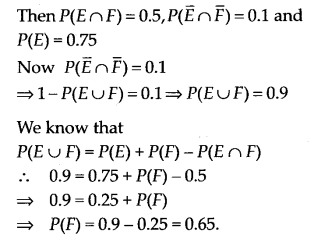
Question 21.
In a class of 60 students, 30 opted for NCC, 32 opted for NSS and 24 opted for both NCC and NSS.
If one of these students is selected at random, find the probability that
(i) The student opted for NCC or NSS.
(ii) The student has opted neither NCC nor NSS.
(iii) The student has opted NSS but not NCC.
Solution:
Here total number of students, n(S) = 60 Let E be the event that student opted for
NCC and F be the event that the student opted for NSS.
Then n(E) = 30, n(F) = 32 and n(E ∩ F) = 24


NCERT Solutions for Class 11 Maths Chapter 16 Probability (प्रायिकता) Hindi Medium Ex 16.3
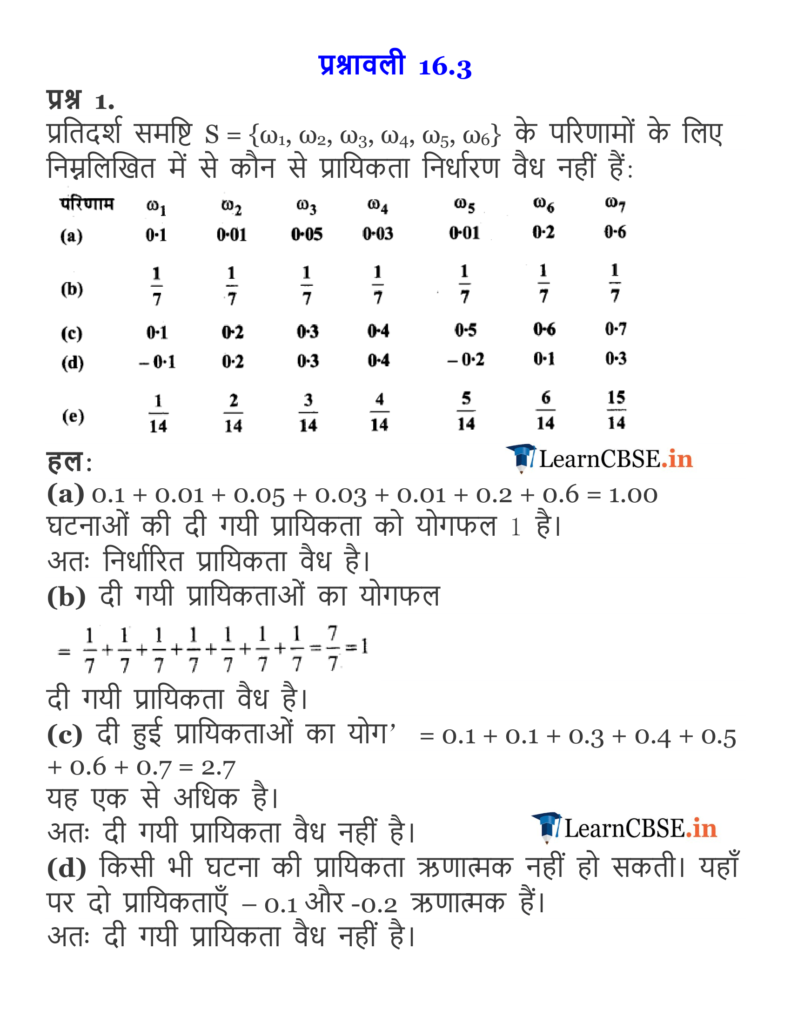
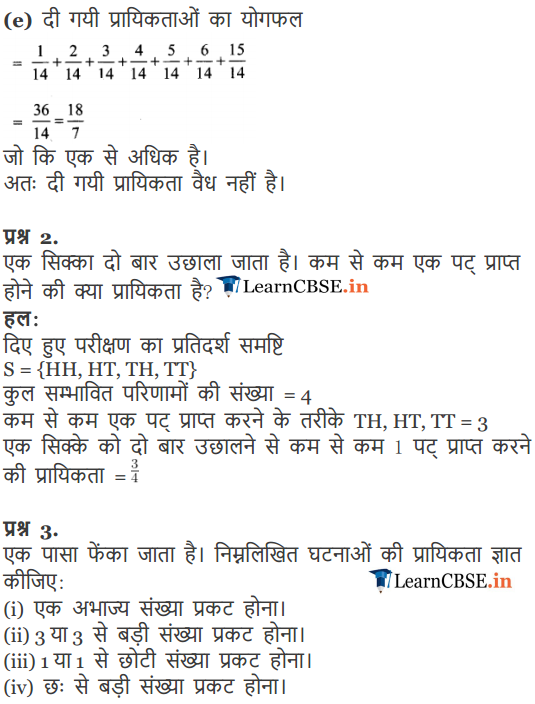
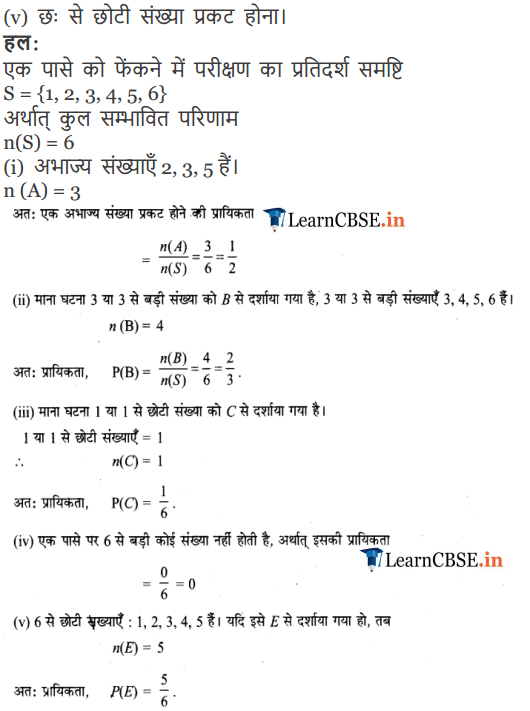
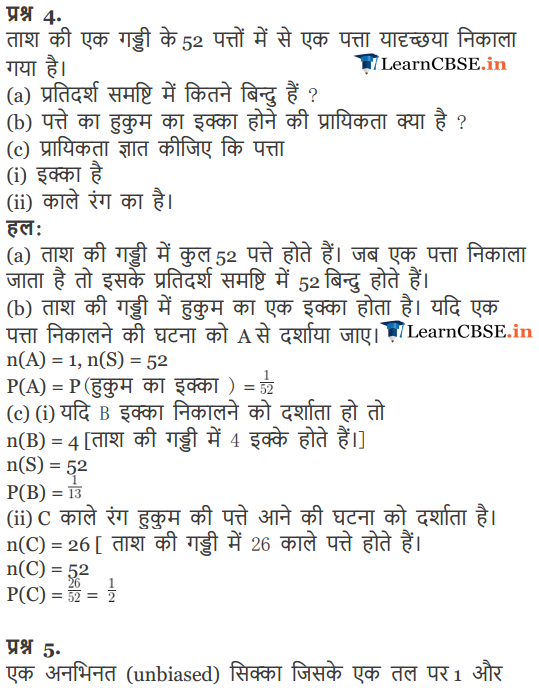
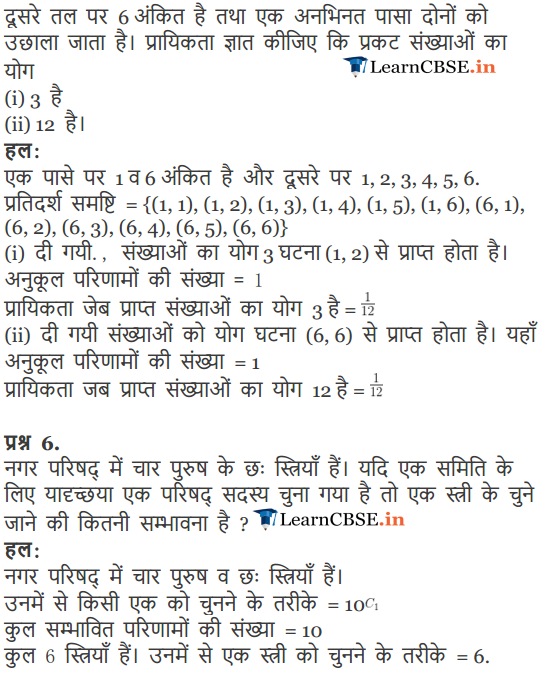
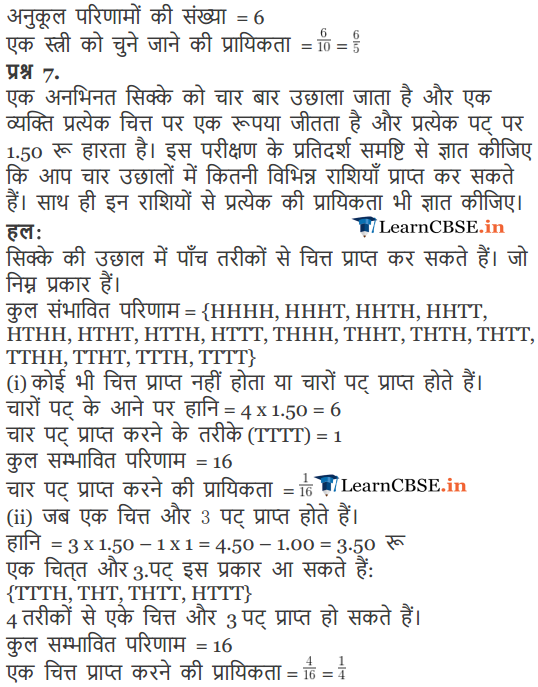
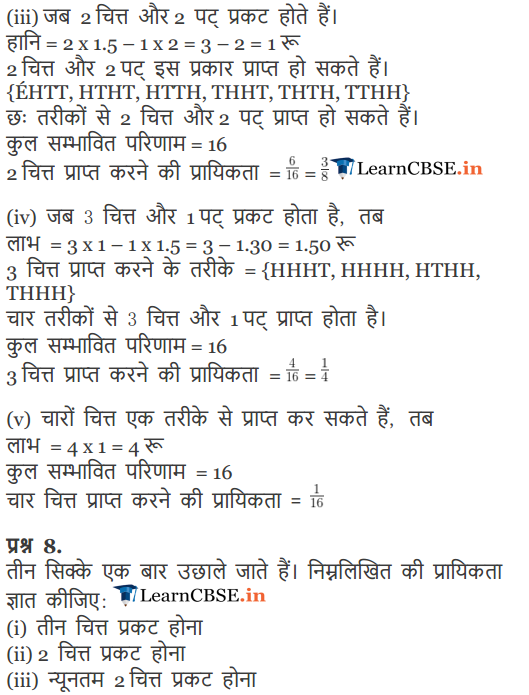
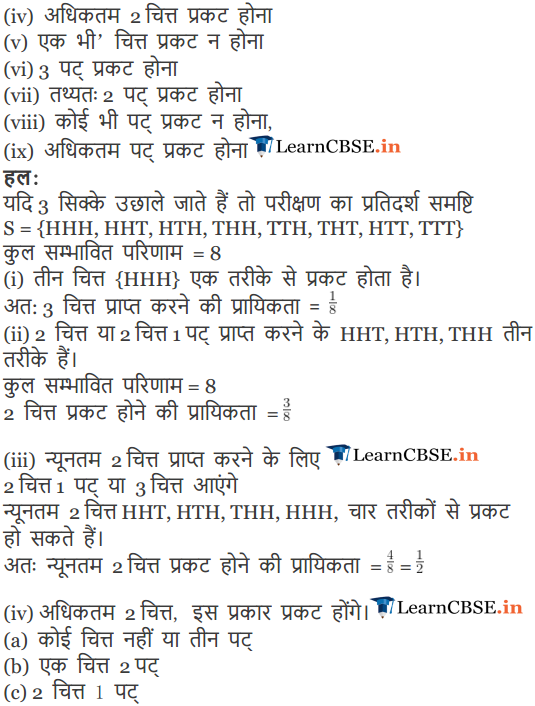
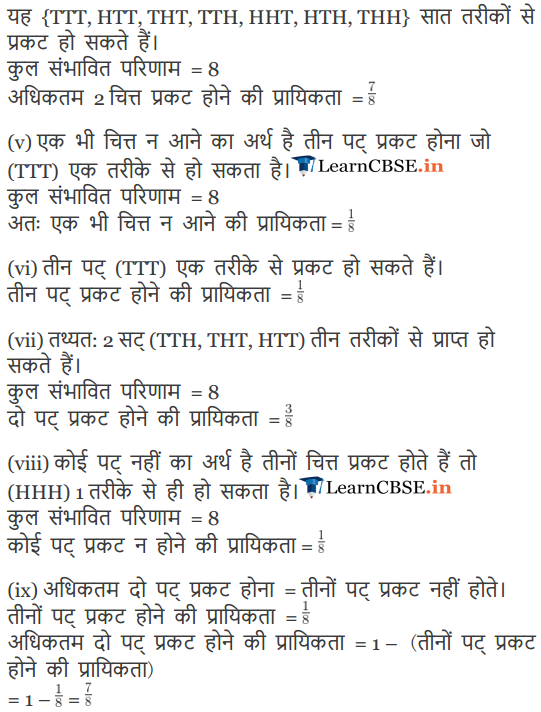

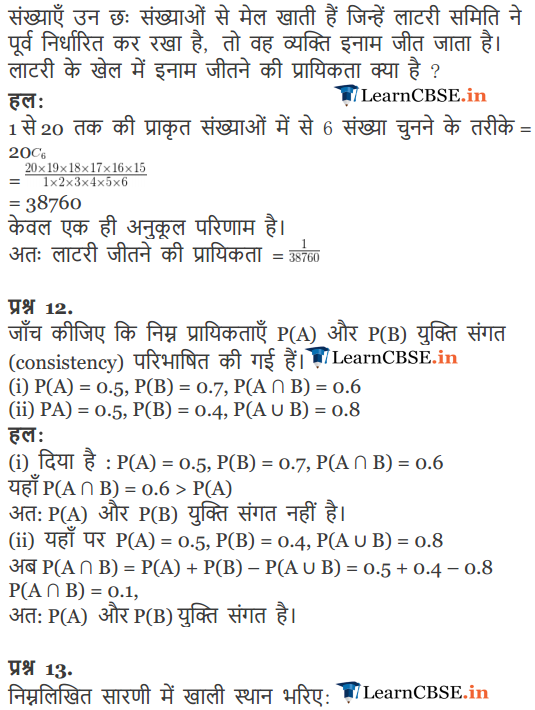
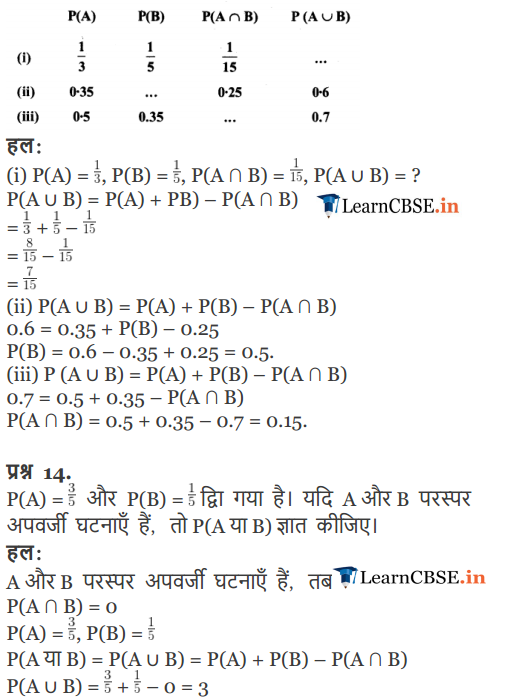
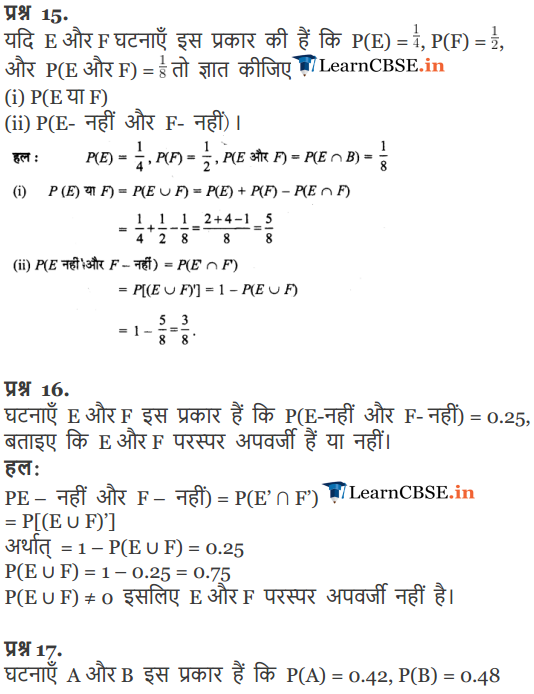
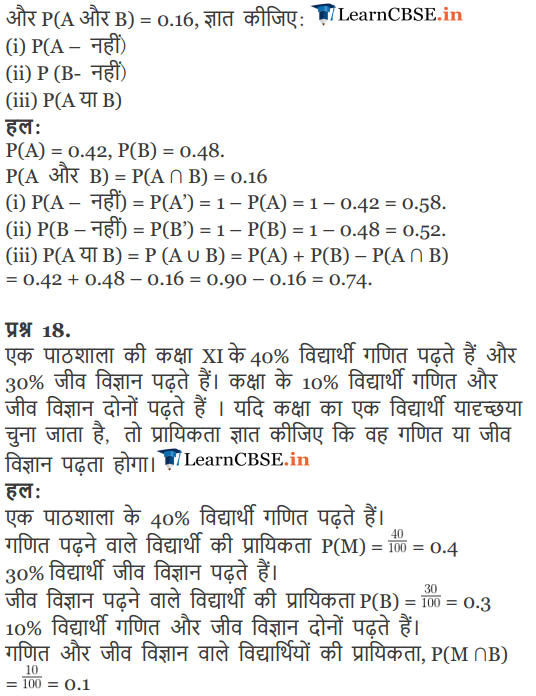
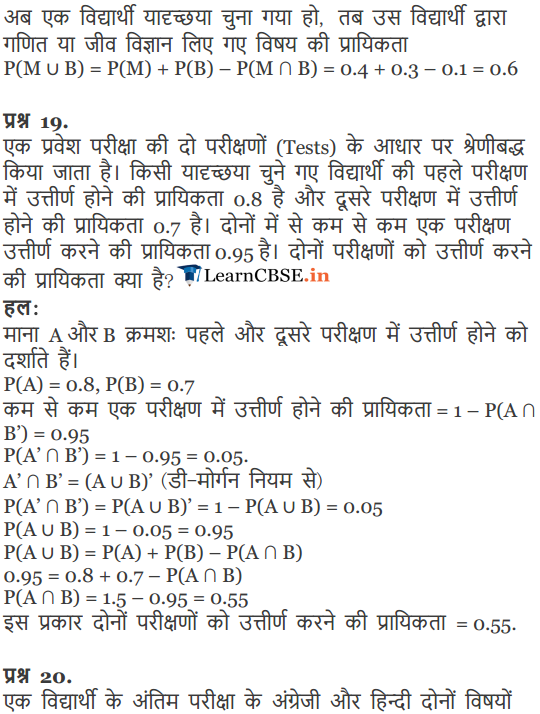

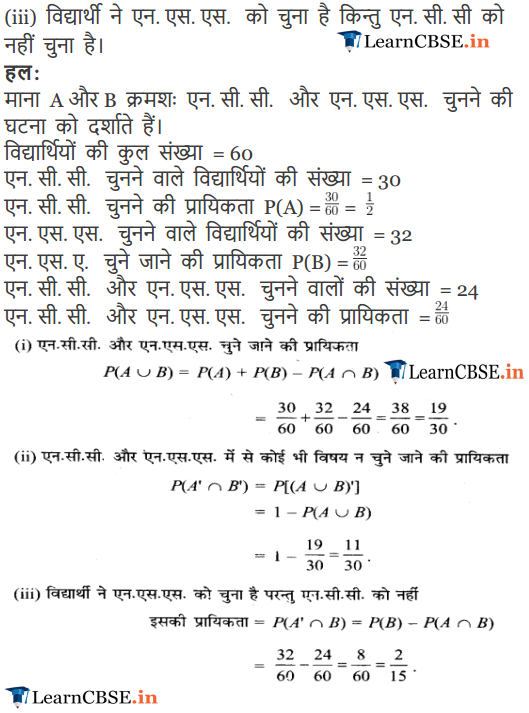
NCERT Solutions for Class 11 Maths All Chapters
- Chapter 1 Sets
- Chapter 2 Relations and Functions
- Chapter 3 Trigonometric Functions
- Chapter 4 Principle of Mathematical Induction
- Chapter 5 Complex Numbers and Quadratic Equations
- Chapter 6 Linear Inequalities
- Chapter 7 Permutation and Combinations
- Chapter 8 Binomial Theorem
- Chapter 9 Sequences and Series
- Chapter 10 Straight Lines
- Chapter 11 Conic Sections
- Chapter 12 Introduction to Three Dimensional Geometry
- Chapter 13 Limits and Derivatives
- Chapter 14 Mathematical Reasoning
- Chapter 15 Statistics
- Chapter 16 Probability